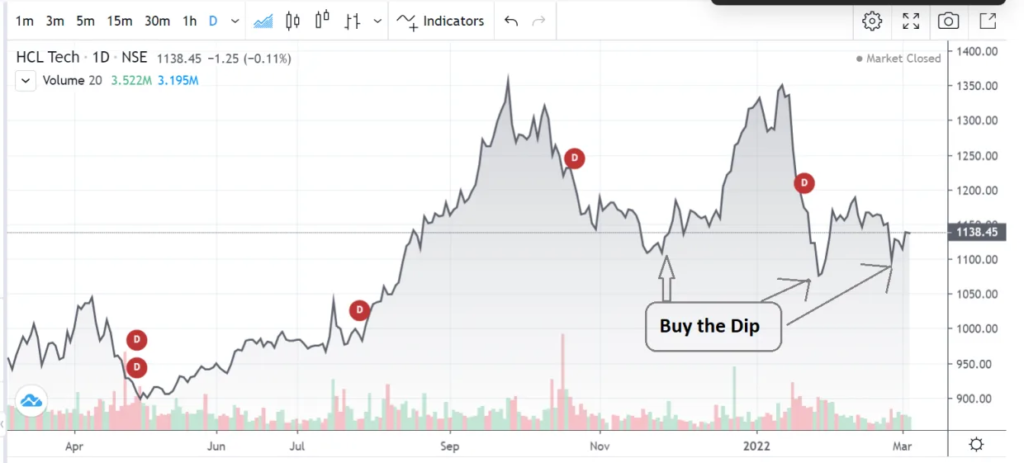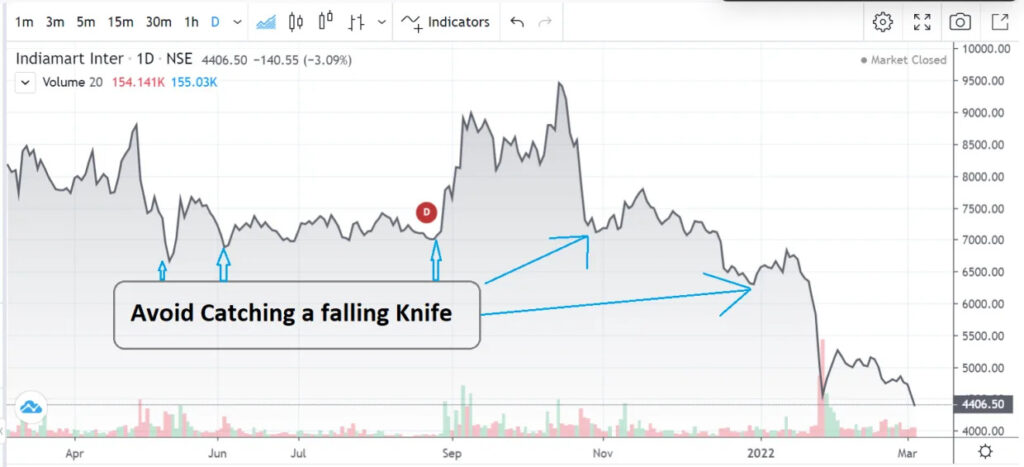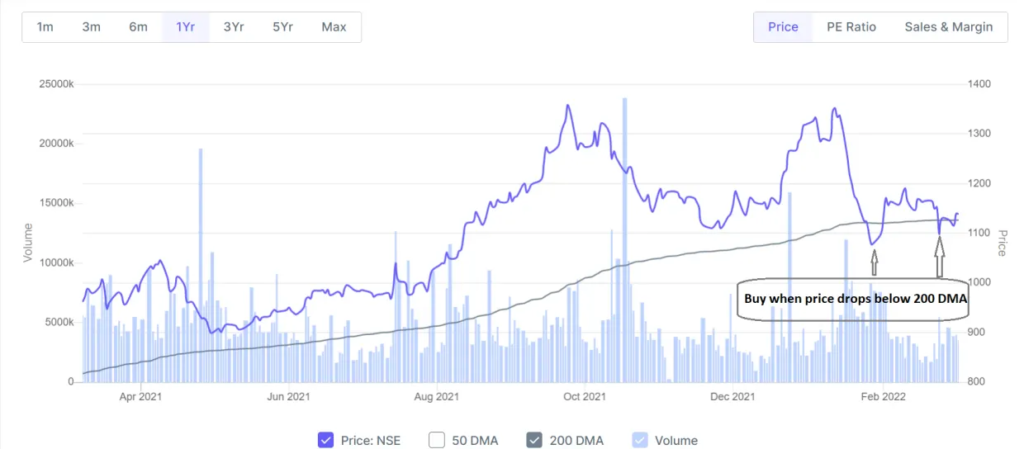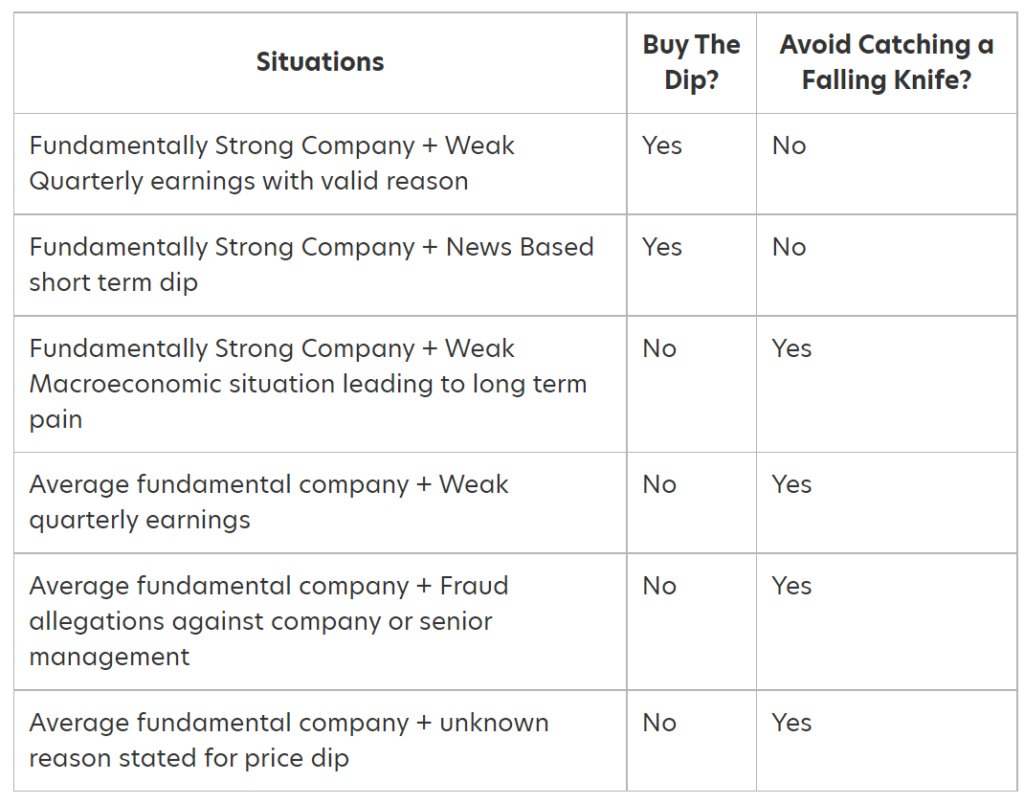0. What is the Fuss?
Investors can get confused by the contrary investment approaches of ‘Buying the Dip’ of a fundamentally good company, vs the approach of ‘Avoid catching a falling Knife’. If the names of these investment approaches are news to you, do not worry, I will cover them in detail in this post. If you have been conflicted in using one approach over the other, this post is the right read for you. I talk about my experience in applying, and restraining at times from these approaches.
Over my investing journey, I have built a more suitable approach – “Buy the news based temporary dip, but refrain from buying a falling stock in a weak macroeconomic situation”. Now this may sound like a mouthful, so let’s take the simplified journey of getting to know this low risk and high return investment approach.
1. Background
Investment gurus often define recommended investment approaches in a simple manner. This enables retail investors to easily understand and follow these approaches.
However, what happens when two such investment approaches are contrary to each other? ‘Buy the Dip’ and ‘Avoid catching a falling Knife’ are two such investment approaches. One of them – ‘Buy The Dip’, recommends buying a fundamentally good stock on each occasion of price drop. The dip in price makes the stock (and resulting valuation) attractive.
The contrarian investment approach is to ‘Avoid catching a falling knife’, which recommends investors to stay away from a stock whose price is falling, as you never know how much further the stock price will fall. You also do not know whether this falling stock will at recover or not. And you also do not know how long will it take for the stock to recover, and are you willing to wait that long in losses?
Even though both these investment approaches are for value investors, they may confuse you, as they did to me. The short answer to this dilemma is that both these investment approaches are valid, and should be applied in the situation for which they are meant to be applied. The long answer is in the following sections.
2. “Buy The Dip” Investment approach
2.1 What is ‘Buy the Dip’ investment approach?
‘Buy the Dip’ is an investment approach for long term, value investors. It means that for a fundamentally good company, with good future growth prospects, an investor should buy every temporary price dip. This price dip can occur owing to unfavorable news or market volatility.
Two key underlying assumptions to note here are:
(a) The stock is fundamentally strong
This in turn means that the company behind the stock has good management who are transparent, and deliver on what they say. The company has a strong moat which keeps competitors and new entrants at bay. This moat can be either via licensing agreements, or by a strong brand recall among customers, or by operational/technical expertise.
(b) Price Dip is temporary
The stock price dip is temporary, and is expected to bounce back soon after. This bounce back time period is usually one to two months. Buy the dip investment approach works in favor of long term investors. It enables these investors to buy long term growth stocks, at attractive valuations.
The key to the right application of ‘Buy the Dip’ approach is to understand its underlying assumptions (mentioned above). When these assumptions are correct, then one should ‘Buy the Dip’. If the assumptions do not hold true, then one should refrain from Buying the Dip.
2.2 When should one Buy the Dip?
Following steps can help you identify a ‘Buy the Dip’ situation:
Step 1: Identify a fundamentally good stock
You can apply GEM framework to identify a fundamentally good stock. G is for Growth. A consistently growing company, with increasing topline (revenue) and bottom-line (profits) is preferred. A historical 5 year average growth rate should be considered for Growth evaluation.
E stands for Efficient Operations. This indicates better operating margins when compared to industry peers, and high Return on Capital Employed (ROCE). This indicates that the company can generate good financial returns from the capital it is deploying to execute its strategy. A ROCE higher than 15% is considered good. Operating Margin more than 10% is considered Good.
M is for Management. A good, committed management can make the difference between high returns vs negative returns. One can look at the years of experience of the management in the industry domain. Another indicator is walking the talk – has the management delivered on what they say in quarterly earnings calls.
I have a details post on GEMS framework for picking stocks, which you can read here.
Step 2: Identify the ‘Temporary’ Price Dip
This step is the tricky part. Let’s begin the journey of identifying temporary vs not-so-temporary price dip. First, we need to respect Mr. Market (the personalized form of the Stock Market). Acknowledge that there is no way a person can accurately predict the movement of the market. As investment veterans – Benjamin Graham and Mr. Warren buffet often say – Mr. Market is an emotional person. Mr. Market sometimes gets over-enthusiastic, and prices a stock at more than its fair valuation. And sometimes, Mr. Market is in a gloomy mood, and prices a stock lower than its fair valuation. The latter situation is what we are looking to identify.
Leading indicators of a temporary price dip in a fundamentally good stock are:
Indicator One: Price dip after a weak Quarterly earnings report: The quarterly earnings of a fundamentally strong company reports either flat revenue or profit increase. The company can also report a dip in revenue or profit, or the revenue and profit increase is not in line with the analysts’ expectation.
Indicator Two: Valid, Temporary uncontrollable reasons for weak quarterly earnings report: Once you have identified indicator one, one should dig deeper into the reasons behind poor quarterly earnings. Some valid, and temporary revenue dip reasons are:
(a) Deferred revenue: Some companies such as IT companies, can get deferred revenue in the next quarter, once the project delivery is done. Take a look at the order book of the company, and the length of the contracts the company has. An order book greater than two times the annual revenue – is a comfortable situation. Long term contracts (spanning more than a year), is also a good indicator.
(b) Seasonal Sales: Some companies have seasonal sales. Example: shrimp manufacturing companies’ sales are higher in the financial quarter of Q4 and Q1. Similarly sales of fertilizers and seeds manufacturing companies increase during sowing season
(c) Raw Material Shortage: A raw material shortage can cause a short term rise in raw materials, leading to decrease in margins of the company. Example: Rising coal prices impacted cement industry margins in Q3’22. Rising oil prices impacted specialty chemical companies’ margins in Q2 and Q3’22. Global semiconductor shortage led to shutdown of automobile manufacturing plants for a couple of months in FY22.
(d) Supply Chain Constraints: Supply chain disruptions may impact sales and margin in the short term for a company. Supply chain disruptions can be caused by higher logistics costs, higher import taxes etc. These constraints are typically short term in nature, and can last from one quarter to up to a year.
(e) Company Specific Reasons: There might be company specific reasons for a short term decrease in revenue. Example: a new acquisition raises the cost temporarily, causing net profit to decline. Appointment of a new CEO may also cause short term confusion, and lack of investors’ confidence in the new CEO’s capabilities – causing the stock price to dip in the short term. Company specific reasons can be identified by reading the quarterly earnings report, and transcript of earnings call.
(f) Macro-Economic Conditions: Short term unfavorable macro economic conditions can negatively impact short term growth prospects of a company, causing a price dip. Example 1: Covid situation driven lockdown led to closure of manufacturing units, or manufacturing units operating at reduced capacity. Irregular monsoons can disrupt rural economy and related demand driven consumer companies’ sales. Example 2: Higher venture capital funding in Indian startups in FY 2022 caused a rise in salaries of IT engineers, leading to increase in attrition for large cap Indian IT companies. This attrition increased from an average of 15% to as high as 25% in FY 22, even for top IT companies such as HCL Tech, Infosys etc.
Above are six commonly observed examples when price dip is temporary. This list of examples is not comprehensive, and there can be more such reasons. However, the broad idea is to understand whether the news, or reasons for weak quarterly earnings is short term, or not.
Short term constraints occur all the time, caused by seasonality, political and geographical risks, and other factors. These temporary dips provide the opportunity to long term investors to ‘Buy the Dip’. Buy a fundamentally strong stock at cheap valuations, and rest assured you can expect to make profit on this investment in the mid to long term.
2.3 How much price dip is the right dip to buy?
A follow up question is to know how much dip is the right dip to buy the stock. Is -1% good, or is it -5%, or is it -10%. Well, the short answer is, a short term dip is expected to be between 5-15%, hence you can buy a dip in this range.
The smart answer is – look at two indicators and place your buy price accordingly – Buy the Dip if the stock price falls below the 200 Day Moving Average (200 DMA) price, and the stock PE is equal to or less than the median PE (Price to Earnings ratio) for past 5 years. This thumb rule will ensure buying the dip at the right “dip” price. This, however, does not mean the the stock price will jump back immediately, and give you profit on the same day. The stock price may go down further, or remain flat, or remain range bound for some days or weeks, before going up again.
I have a dedicated post on using 200 DMA and PE combination to select right stock price. You can read the post here to know in detail on this stock price valuation rule, and scenarios where you can apply it.
Example: HCL tech – a fundamentally strong company, with stable to positive growth outlook, gave three opportunities in FY22 to buy the dip. This was owing to weak Q322 earnings, with shrinking profit margins and higher than average attrition rate, which was a common problem for almost all IT companies in Q322.

Do note that as of writing this post in November 2022, IT sector is facing global headwinds in the tech industry. Due to this headwinds, the overall IT sector has fallen much further. However, stocks like HCL tech have been the first to bounce back from this fall, and are maintaining their valuation and price point.
3. ‘Avoid catching a falling Knife’ Investment approach
3. 1 What is “Avoid catching a Falling Knife” investment approach?
As investment veterans often say, ‘In the stock market, it is more important to not be stupid, than it is to be smart”. Not being stupid all the time wins over being smart some of the times. Extending this concept to the fall in price of a stock – when the price of a stock has been falling continuously over several days/weeks, stay away from it.
Do not buy the dip of a continuous falling stock, because you never know at what price the stock will settle into, before going up again. You do not know whether the stock will ever go up again. Buying a falling stock is akin to catching a falling knife – you will get hurt, and lose money.

This concept is similar to momentum investing concept, which states that a stock whose price is rallying up, will keep on increasing for some more time. And a stock whose price is falling, will fall for some more time, owing to the negative momentum it has gathered.
3.2 When should one Avoid catching a falling Knife?
Following situations are some when you should avoid buying a falling stock:
Situation 1: Worrying reason, or No-reason for Poor Company performance
If the performance of the company has been going down for more than one quarter, and there are no convincing answers from the company’s management, you should be worried. A strong company with sound management, will know exactly what the reason behind poor performance of the company is, what they are doing to fix it, and when they expect to be back on track.
If the management offers no clarity on the reason for continued weak earnings, and on the future prospect of the company, stay away. Generic statements by the company, such as: “We are looking into it with priority”, “We are confident of a better upcoming quarter” are not good enough. There has to be a certainty in quarterly earnings call, backed by data, and valid reasons, which can be verified online. There should be a concrete plan of action aimed at recovery, with clear timelines to achieve them. Without this, investors are unsure of the recovery in the company’s performance, and similar recovery in the stock price.
Situation 2: Fraud related News
Investors should stay away from companies, at least in the short term (up to one year), from companies whose top management has been accused of fraud. Fraud news can include insider trading, siphoning off money to family members, fudging the accounting books to inflate revenue or profits etc.
If the management is accused of fraud by a regulatory body, or an audit agency, then stay away, while you do more research. If the fraud accusation is by a rival company, or an ex-employee, then do your research before deciding to invest. A similar situation is when the top management is ousted by the company’s promoters, or company’s board. Stay away from investing in these companies in the short term as well.
Situation 3: Long Term Known Pain
If there are valid reasons for poor performance of a company. And these valid reasons will not go away in the near future, then stay away from investing in these stocks. Example: Covid driven lockdown led to drop in business of hotels, and travel related stocks. This pain continued for two years – from 2020 into 2022. Hence stay away from these stocks, and do not buy the dip as you are unsure of the uptick in business in the short term – unless there are concrete actions by the government to uplift travel restrictions.
Do note that when these unfavorable situations start clearing up, then is a good time to invest. Taking the same example, post upliftment of Covid Lockdown by June 2022, travel and hospitality stocks have rallied in H2 2022.
The best plan of action for a falling stock is to wait it out, let the price stabilize. Meantime, you can research the company, find the right valuation price of the company including margin of safety, and look for chart patterns that signal an uptick in the stock price before jumping in on this stock’s (expected) upward journey.
Example: Indiamart – Indiamart stock dipped several times by upto 10% in FY 2022, triggering retail investors to jump on to buy the dip. But then, it tanked by 14% further after posting a weak Q321 earnings (a total of 40% fall over three quarters of FY 2022). Post this, the CEO of the company clarified that margin contraction was expected, and expected this to continue in coming quarters.

4. Framework to choose ‘Buy The Dip’ vs ‘Avoid catching a falling Knife’
Below are some pointers to help you decide between when to apply which investment approach, followed by a table summarizing the key learnings and situations in this post.
4.1 Stick with a fundamentally good company
Focus on identifying a good company, with a moat, good management, consistent past performance, and operating in a sunrise industry. With a fundamentally sound company, who is increasing its revenue, profit, and market share over time, you will seldom go wrong. Buying the dip is an alright approach with such companies.
4.2 Use the 200 Day Moving Average Price
Many investors, and day traders go by this rule. When a good company’s price falls below its 200 days moving average price, then buy the dip.
Example: HCL Tech – Buy the dip situation occurred when stock price dipped below 200 Day Moving Average (DMA), which coincides with buy the dip in below figure.

4.3 Use PE to Avoid catching a falling Knife
After a dip in price of a stock, if the new PE is still higher than past 5 year median PE of the company, then do NOT buy the dip. It means that the stock price may still fall more. Another indicator to look at is whether the market is in a bull run or a bear run. If the market is in a bear run (overall market index PE is less than 25), then wait for some more correction to happen, as you do not know the base of the bear run, before the market starts going up again. However, if the market is in a bull run (overall market index PE > 25, and consistently rising over the past 6 months), then you may as well buy the dip.
4.4 If you are unsure, stay away
If you have done your research, and still do not know the main reason for the dip in stock price, stay away. Typically, research via quarterly earnings calls, online news articles, reading ratings reports etc. you should be able to get a clear answer of the reason behind stock price fall, and by when the underlying reason for this fall will correct, allowing the stock price to go up again. No reason is a reason to worry. It can indicate poor management judgement, management not being transparent with their investors. Or it can indicate some deeper reason, of which the retail investors are not aware of. Better stay at bay, rather than tread in unknown waters.
Below table shows a quick recap of what we discussed in section 3 and 4.

5. Parting Thoughts
I hope you can now create your own framework of when to buy the dip, and when to avoid catching a falling knife. It is important to do company specific research, and not blindly follow investment mantras on face value.
Did you face a similar situation recently, where you bought the dip, or avoided catching a falling knife? Do share in comments below.
Happy Investing !
Disclaimer: This post is not an investment advice. Please do your own research before investing.




